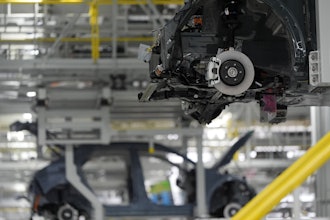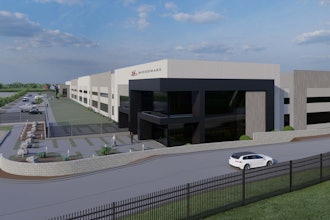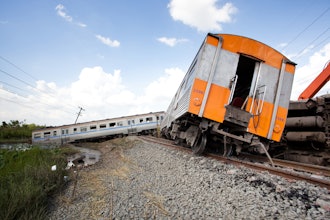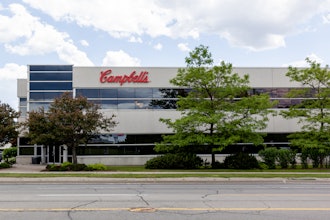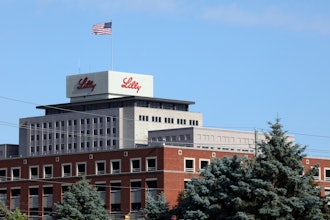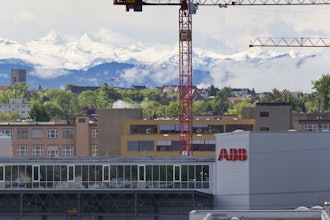In a recent survey, we asked readers what they most want to find in the pages of CHEM.INFO magazine. Innovation was the top response. In fact, it was the most popular and passionate request. As a result, we have searched the marketplace for innovative ideas and have assembled this special report examining 10 cutting-edge technologies. We hope they help you bring innovation into your plant.
Reliable Diaphragm Pumps With Special Valves and Seals

Design flaws in pumps can cause the loss of production and many headaches for plant managers. Poor performance is exhibited in a variety of ways including decreased flow, freezing, stalling, motor corrosion, leakage, poor energy efficiency, and "blow-by" of compressed air. These common ailments create downtime and require continual maintenance, often making the purchase price of a diaphragm pump the smallest piece of the cost-of-ownership pie. Well designed pumps prevent downtime and save energy, requiring fewer parts and less labor over the life of the pump. A balanced air valve design is a common flaw in many pumps today. This air valve design eventually centers and stalls the pump, forcing operators to strike it with a hammer to "kick-start" the air valve. Bad valve design also creates air blow-by. Blow-by is often caused by a metal-to-metal lapped-fit valve design that permits air to leak past the valve and exhaust to the atmosphere, creating a significant decrease in energy efficiency. ARO Expert (EXP) Series diaphragm pumps feature SimulShift valves and positive seals to prevent downtime caused by stalling and blow-by. The pumps also include Quick-Dump valves to eliminate downtime caused by freezing. SimulShift valves provide ultra-positive shift signals that deliver faster trip-over with less pulsation. The valve design is engineered to maximize energy efficiency, providing a more consistent material flow. ARO EXP diaphragm pumps also feature D valves, which provide a positive seal during valve shifts. These D valves, which are ceramic for longer life, ensure optimum energy efficiency by avoiding air blow-by. It's estimated that these and other energy-saving features on ARO EXP diaphragm pumps can save plants more than $600 a year per pump.
Ingersoll Rand, 419-633-1285, www.irtools.com/aro
Ultrasound Technology for Detection and Analysis

One of the most useful, necessary, and widely used technologies in predictive maintenance of plant equipment is ultrasound. Working autonomously or in conjunction with traditional condition-based monitoring technologies, such as infrared and vibration, ultrasonic instruments cover a broad range of plant operations that include inspection for potential failure in all types of equipment and systems. Used in energy conservation, predictive maintenance, safety, and quality assurance programs, ultrasound technology helps companies, large and small, become more productive and improve their bottom line by increasing asset availability, improving production capability, and reducing energy waste. Typical applications for the chemical industry include the trending of mechanical equipment and bearing maintenance as well as condition-based lubrication of bearings. Other applications are leak detection, vacuum and pressure inspection, compressed air leak testing, cavitation, and electrical discharges such as corona, tracking, and arcing. Ultrasonic instruments also identify faulty valves and steam traps. The main benefit of the technology is its ability to identify early warning signals accurately in mechanical equipment before actual failure. Airborne ultrasound instruments provide information by hearing translated ultrasounds through noise-isolating headphones and as intensity level (DB) on a display panel. More advanced ultrasound instrumentation can perform condition analysis, record sounds, and store and manage data via state-of-the-art spectral analysis and data management software. That is precisely what makes these instruments so useful — they allow inspectors to confirm a diagnosis immediately by being able to discriminate among various equipment sounds. Used by hundreds of chemical companies, ultrasonic instrumentation has become one of the main components of a plant's predictive maintenance program.
UE Systems Inc., 914-592-1220, www.uesystems.com
Reciprocating Gas Compressors and Vapor Recovery Capabilities

The LB Series single-stage, oil-free reciprocating gas compressors for LP gas applications can improve railcar unloading efficiency and profitability. They increase transfer volume by approximately 3 percent due to the compressor's superior vapor recovery performance and, unlike pumps, empty a LP gas vessel completely of product. Many liquefied gas transfer applications can be handled more efficiently with a gas compressor than a liquid pump. This includes the unloading of transports and pressure vessels — where system piping can restrict flow and cause excess cavitation in the pump — the unloading of LP gas from railcars, and other installations that require removing the liquid from top-opening tanks. LB Series compressors create a slight pressure differential between the vessel being unloaded and the receiving tank. The suction stroke of the compressor piston draws in vapor and decreases the receiving tank pressure. The discharge stroke moves a measured volume of vapor at a higher pressure into the supply tank where it displaces an equal volume of liquid through a separate line into the receiving tank. Generally, the liquid flow rate will be 5-6 gpm for each cubic foot of piston displacement. At the conclusion of the liquid transfer phase, a significant amount of product (vapor and liquid) is left in the tank car, often 3 percent or more of the tank's capacity. Based on a 33,000-water-gallon-capacity tank car, unloaded using an LB361 gas compressor with 36 CFM and the vapor pressure gauge reading 150 psi, there would be approximately 1,315 gallons of LP gas in vapor form remaining in the tank car. Of this amount, the LB Series can economically recover 845 gallons in less than three hours.
Blackmer, 405-942-6622, www.blackmer.com
Effective Pollution Control for Coarse and Fine Particles


Cloud Chamber System (CCS) technology is an effective air pollution control for exhausts that produce coarse, fine, or submicron particles. It passes the dirty gas stream through a "scrubbing cloud" of high-density charged water droplets. Inside, billions of charged droplets interact with the particle-bearing process stream. When a particle and droplet pass within 20 microns, electrical forces pull the particle into the droplet. As a result, each individual water droplet becomes a particle collector. Droplets collect particles as they interact with the process gas stream and then "rain" into a sump. Captured particles agglomerate and settle and then are removed as low-volume slurry. Clean water from the top of the sump is re-circulated to the charging grid, completing the cycle. There are no fibrous filters, collector plates, venturi throats, layered pads, bags, or cartridges. Coarse particles are easily removed. Fine particles between 0.1 and 2.5 microns are removed at efficiencies of 99 percent or better. Even 0.01 micron particles can be treated after agglomeration growth in the system's "pre-conditioning" section. CCS technology is also cost-effective. When gas scrubbing is required with particle removal, further savings are realized because CCS technology eliminates the separate scrubber. CCS charge modules require a maximum of 10 watts of power per 1,000 cubic feet per minute (cfm). A 100-watt light bulb draws as much power as a charging head for 10,000 cfm. Power consumption for charging is usually 1 percent or less of that required by ESPs. The main power draw is recirculating pumps.
Tri-Mer Corp., 989-723-7838, www.tri-mer.com
Pneumatic Fluidizing Conveyors and Flowability Requirements

Air-Flow Conveyors are pneumatic fluidizing conveyors that are sometimes called air-activated gravity conveyors. They consist of a fixed inclined rectangular fabricated shape, which is divided longitudinally into two parts by a partition consisting of a media permeable to air. The upper and larger portion is the product conveying area. Low-pressure air is blown into the sealed lower portion and permeates through the media fluidizing a small portion of the product. Due to a predetermined angle of decline, the product is able to flow like water down a river bed. One advantage of these conveyors is the fact they have no moving parts, which translates to very low maintenance. Another advantage is their capability to convey fine powder. They also offer high volume flow rates at minimal cost. Their low power consumption is said to be lower than any other powered system. Currently, work is being done to use nitrogen gas, instead of air, in some applications in order to eliminate the possibility of explosion and to use the air to cool the product as it is conveyed. It's interesting to note that product can be tested for flowability in a plexiglass-sided unit, which allows the flow to be reviewed. The conveyors are ideal for industries and applications where "flowability" is an important requirement. An example is the barge loading system shown here. Barges are loaded by eight 30-foot retractable spouts with integral dust collectors. Feeding these spouts are more than 520 feet of conveyors. The system also includes eight air-actuated vertical slide gates.
BayShore Material Handling, 231-347-1160, www.bayshoresteel.com
Permeation Barrier System for Fuel Hose Vapors


Did you know that 190 billion gallons of fuel are used in the U.S. each year? And did you know that about 10-18 grams of fuel per gallon are lost through permeation through fuel hoses? If you choose the more conservative figure of 10 grams, the calculated loss comes to about 627 million gallons of fuel each year. This staggering estimate comes from a research study published by Dr. Mark Deluchi & Associates, University of California, Berkley. If you imagine an average price of $3 per gallon, the 627 million gallons of lost fuel translates into $1.88 billion. In order to stop such fuel loss, an effective new technology has been developed. Called Vapor-Loc, it's a hydrocarbon fuel hose vapor permeation barrier system. Its multi-layered system traps and prevents 97 percent of the vapors given off by hydrocarbon fuels, including gasoline, gasoline/ethanol blends, diesel, and oil, as well as the hydraulic fluids inside the hose from permeating to the outside environment. This environmentally friendly system not only reduces fuel loss but also decreases air pollution, virtually eliminates smelly fuel and chemical fumes, improves the hose's reinforcement, and protects against excessive flexing under pressure. It's believed that the system's widespread use in hydrocarbon fuel and chemical transfer hoses, gas station fueling pump hoses, and fuel line hoses in vehicles and trucks could have a significant impact on atmospheric pollution levels. The Vapor-Loc tank truck hose is the first of many products to be introduced that uses the Vapor-Loc technology. The hose is available in various sizes from 1- 4 in. ID, comes with a smooth or corrugated cover, and offers full working pressures of 150-200 psi based on hose size and style.
HBD/Thermoid Inc., 800-543-8070, www.hbdthermoid.com
New Rotary Shaft Seals and Water Conservation

The Hydra-Just is a new "leak-free" rotary shaft sealing system engineered to make traditional mechanical seals and packing obsolete. Unlike mechanical seals and packing, it does not use water to lubricate seal surfaces. It forms and maintains a bearing relationship to the shaft face in the seal chamber while preventing the process media from migrating into the stuffing box. This revolutionary design effectively creates a new sealing category — a radial bearing-to-face seal. This is key to its success, particularly in abrasive service applications. What significance does it have for the process industries? First, the technology eliminates the risk of catastrophic failure. It also reduces unplanned outages, which saves time and money. In addition, it increases manufacturing capacity and throughput because it enables the plant to schedule maintenance activities around production time instead of scheduling production time around maintenance activities. Moreover, since the running of a profitable company requires the conservation of its resources, Hydra-Just makes business sense because it promotes water conservation. In fact, it significantly reduces water consumption. Average water use with the Hydra-Just is 3-10 gallons per hour. Another advantage of the technology is fast installation — it can be installed in less than one hour instead of the two-and-a-half or three hours required by a mechanical seal. Finally, the technology typically costs 25 to 50 percent less than mechanical seals.
Garlock Sealing Technologies, 315-597-3104, www.garlock.com
On-Line Organic Analyzer With Patented Self-Cleaning

The BioTector is a continuous on-line total organic carbon (TOC) analyzer for environmental monitoring, process control, and waste minimization. While conventional TOC analytical methods were initially developed for laboratory applications and then modified for on-line purposes, the BioTector has been specifically developed for on-line TOC measurement in process applications. Through complete oxidation of the sample, it eliminates buildup issues that lead to drift and high-maintenance costs. Complete oxidation of the representative sample is the key. The analyzer uses hydroxyl radicals to fully oxidize the sample, drastically minimizing drift. Its patented self-cleaning technology diminishes traditional maintenance requirements and virtually eliminates filtration. No calibration is needed between the suggested six-month preventative maintenance services. The result is better than a 99 percent on-line time, which in turn reduces the time and costs associated with routine maintenance. The BioTector outputs up to 86,000 measurements per year with an accuracy of ۭ percent of reading. It has automatic range selection and multi-streaming features with capabilities of up to eight streams (six process streams). It makes direct measurements without dilution on ranges up to 15,000 mg c/l in a six-minute cycle and up to 100,000 mg c/l in a 12-minute cycle. While other technologies fail with fats, greases, and oils, the BioTector can measure particulates up to 2 mm without filtering. This allows it to handle chlorides up to 25 percent and calcium sludge up to 12 percent by volume. It can also oxidize very large samples — up to 10 ml — which is up to 1,000 times larger than standard technologies.
Ohmart/VEGA Corp., 513-272-0524, www.ohmartvega.com
Peristaltic Pumps for Metering the Most Corrosive Chemicals

Chemicals such as hydrochloric acid, sodium hydroxide, sodium hypochlorite, and sulfuric acid are a few examples of the chemicals used throughout the world for processing applications in a variety of industries. They are also the chemicals that can cause pump failures and grind processes to a halt. When faced with the challenge of installing a mechanical pump in the heart of their process to meter aggressive chemicals, engineers need to find a pump that is quick and simple to operate and maintain, that can withstand harsh chemicals, and that will run reliably and meter accurately. New high-pressure pumps and chemical-duty tube elements are capable of meeting these needs and optimizing chemical usage and product yield in even the most intense high-pressure chemical injection applications. These pumps and controllers are offered in complete stand-alone "case drive" packages with a five-year warranty. With no separate or complex parts, the pumps are simple to operate and virtually maintenance-free, and the tube elements can be changed in just minutes. The peristaltic pumps are seal-less and valve-less. With no internal ball checks that are susceptible to corrosion, clogging, or vapor lock, they are able to withstand harsh chemicals and to run reliably for extended periods of time. Additionally, thanks to built-in microprocessor DC variable speed controls, they are capable of achieving ultimate metering controllability up to 3600:1 with 0.1 rpm increments along the entire range — a level of precision well beyond the control capability of conventional metering pumps.
Watson-Marlow Bredel, 800-282-8823, www.watson-marlow.com
Dust Collection Filter With Extended Service Life

As environmental requirements become increasingly stringent, today's chemical plants seek more effective and affordable solutions for dust collection. The HemiPleat filter helps achieve these goals because it offers greatly extended service life and lower pressure drop compared to standard dust collector cartridge filters — typically double the life at half the delta P. The line includes filter elements to fit all types of dust collectors, providing high efficiency capture of dry processing dusts including toxic dusts. Conventional cartridge filters use tightly compressed pleated media. Much of the media surface is unavailable for filtering, and as a result, dust remains trapped within the filter even after pulse cleaning. The patent-pending HemiPleat uses an innovative media pack design that holds the pleats of the cartridge open, making virtually all the media surface available for filtration. The wide, open spacing results in lower pressure drop and causes dust to release more readily from the cartridge during cleaning, using less compressed air and less energy. Testing shows that the HemiPleat cartridge also holds more dust than conventional filters, allowing a longer time period between cleaning cycles. In addition, the HemiPleat filter media offers high efficiency (99.99 percent on 0.5 micron particles and larger) and high moisture resistance. An ultra-high efficiency media (MERV 15 or 99.999 percent on 0.5 microns) is also available. In many applications, cleaned air may be recirculated through the plant downstream of the dust collector for energy savings.
Farr Air Pollution Control, 800-479-6801, www.farrapc.com
BONUS: And Now a Word About Software...
Editor's Note: Although there are no software packages among the 10 technologies highlighted in this special report, dramatic strides are being made in this arena. So, we decided to add this "bonus" to our "10 Technologies" report with a look below at one specific type of software that is making a significant impact.
Most chemical engineers, at some stage, have been exposed to a computational fluid dynamics (CFD) simulation with results presented as a few colorful pictures at the end of a report or, with a little luck, as an animation in an otherwise boring technical presentation. Put simply, in the eyes of many chemical engineers, CFD has been an amusing distraction from such traditional tools as experimentation or empirical correlation. Not anymore. CFD is no longer just about fluid dynamics. CFD simulations are now regularly used to solve problems involving structural mechanics, heat transfer, phase change, and chemical reaction. CFD, which should more properly be called computational continuum mechanics, is routinely deployed at the earliest stages of the chemical engineering design process, along with traditional tools, to provide rapid insight into how a process will perform before the first prototypes are built or the first experiments performed. CFD software's flexibility and extensive range of thermo-physical and chemical modeling capabilities have made it a highly effective tool for a huge range of applications.
CD-adapco, 631-549-2300, www.cd-adapco.com




















